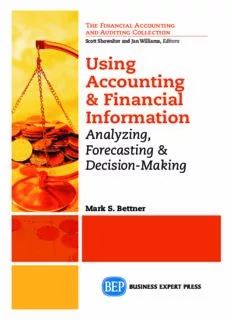
Using accounting & financial information : analyzing, forecasting & decision making PDF
Preview Using accounting & financial information : analyzing, forecasting & decision making
The Financial Accounting and Auditing Collection Scott Showalter and Jan Williams, Editors Using Accounting & Financial Information Analyzing, Forecasting & Decision-Making Mark S. Bettner Using Accounting & Financial Information Analyzing, Forecasting, & Decision Making 9781606496404_Print.indd 1 13/12/14 2:22 PM 9781606496404_Print.indd 2 13/12/14 2:22 PM Using Accounting & Financial Information Analyzing, Forecasting, & Decision Making Mark S. Bettner, Ph.D Christian R. Lindback Professor Bucknell University 9781606496404_Print.indd 3 13/12/14 2:22 PM Using Accounting & Financial Information Copyright © Business Expert Press, LLC, 2015. All rights reserved. No part of this publication may be reproduced, stored in a retrieval system, or transmitted in any form or by any means—electronic, mechanical, photocopy, recording, or any other except for brief quotations, not to exceed 400 words, without the prior permission of the publisher. First published in 2015 by Business Expert Press, LLC 222 East 46th Street, New York, NY 10017 www.businessexpertpress.com ISBN-13: 978-1-60649-640-4 (paperback) ISBN-13: 978-1-60649-641-1 (e-book) Business Expert Press Financial Accounting and Auditing Collection Collection ISSN: 2151-2795 (print) Collection ISSN: 2151-2817 (electronic) Cover and interior design by S4Carlisle Publishing Services Private Ltd., Chennai, India First edition: 2015 10 9 8 7 6 5 4 3 2 1 Printed in the United States of America 9781606496404_Print.indd 4 13/12/14 2:22 PM Abstract Accounting often is referred to as the language of business; unfortunately, many business professionals lack the fluency in this unique language required to perform basic financial analysis, prepare budgetary forecasts, or compare competing capital investment alternatives. And while there is no shortage of financial-related textbooks or reference manuals, most assume that readers have educational backgrounds – and/or have had years of professional experience – in accounting, financial analysis, or cor- porate finance. This book targets professionals with limited exposure to – or formal training in – accounting or related finance disciplines. These individu- als often include – but certainly are not limited to – engineers, infor- mation technology specialists, retail managers, entrepreneurs, marketing directors, construction contractors, attorneys, and even bankers who are making career transitions from consumer lending positions to become commercial loan officers. The primary purpose of this book is to help managers and busi- ness owners from diverse professional and educational backgrounds to: (1) converse more effectively with their accounting and finance col- leagues; (2) understand the structure and the elements of general-purpose financial statements, (3) identify both the usefulness and the limitations of accounting information; (4) prepare basic financial forecasts; and (5) make sense of commonly used decision-making models. Keywords Accruals, accounting, financial statements, balance sheet, income state- ment, statement of cash flows, assets, deferrals, liabilities, equity, revenue, expenses, cash flow, financial analysis, financial management, profitabil- ity, solvency, liquidity, budgeting, decision-making, financial forecasting, pro forma financial statements, cost–volume–profit analysis, breakeven, capital budgeting, payback period, discounted present-value, internal rate of return, net present value, time-value of money. 9781606496404_Print.indd 5 13/12/14 2:22 PM 9781606496404_Print.indd 6 13/12/14 2:22 PM Contents Dedication .........................................................................................viii Chapter 1 Users of Accounting & Financial Information ...................1 Chapter 2 Corporate Financial Statements .......................................13 Chapter 3 Accrual & Deferral Timing Differences ...........................35 Chapter 4 Financial Statement Analysis ...........................................47 Chapter 5 Long-Term Financial Forecasting ....................................67 Chapter 6 Operating Budgets ..........................................................87 Chapter 7 Cost–Volume–Profit Relationships ................................101 Chapter 8 Capital Budgeting .........................................................119 Index .................................................................................................135 9781606496404_Print.indd 7 13/12/14 2:22 PM Dedication Dedicated to the wonderful Batalden family of Lamberton, Minnesota. 9781606496404_Print.indd 8 13/12/14 2:22 PM CHAPTER 1 Users of Accounting & Financial Information Accounting is often referred to as the language of business; unfortunately, many business professionals lack fluency in this unique language, making it difficult for them to perform basic financial analysis, prepare budget- ary forecasts, or compare competing capital investment alternatives. Although there is no shortage of well-written accounting textbooks, bud- geting manuals, or finance publications, most require that readers have educational backgrounds and/or professional experience in accounting and financial management. This book targets individuals in management positions with limited exposure to—or formal training in—the disciplines of accounting and finance. These professionals include engineers, information technology specialists, entrepreneurs, marketing managers, construction contractors, attorneys, and even bankers who have transitioned from consumer-lending positions to become commercial loan officers. Throughout this book accounting and financial reporting subjects are addressed from a user’s perspective. Thus, topics such as transaction analysis, journal entries, and numerous other recordkeeping procedures associated with financial statement preparation are avoided. Its purpose is to help managers from diverse professional and educational backgrounds to (1) converse more effectively with their accounting and finance col- leagues; (2) appreciate the usefulness and limitations of general purpose financial statements; (3) use accounting information in decision-making processes; (4) develop short- and long-term financial forecasts; and (5) make sense of commonly used decision-making models. 9781606496404_Print.indd 1 13/12/14 2:22 PM
Description: